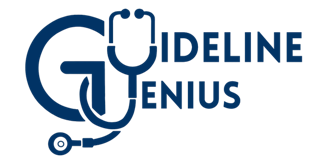1. By accessing or using this website, you agree to comply with and be bound by these terms and
conditions. If you do not agree with any part of these terms and conditions, you must not use
this website.
2. Use of the website: This website is for informational and educational purposes only and is
intended for medical professionals. You agree to use the website in a lawful manner and to
refrain from activities that may disrupt its functionality or compromise its security.
3. Intellectual property: All content on this website, including but not limited to text,
graphics, logos, images, and code, is the property of Guideline Genius LTD unless otherwise
stated. Unauthorised reproduction, distribution, or use of the website's content is strictly
prohibited without prior written consent.
4. Subscriptions and payments: Certain sections of the website may require a subscription for
access. By subscribing, you agree to pay any fees specified during the subscription process. All
fees are non-refundable unless otherwise specified.
5. Accuracy and updates: While we strive to ensure the accuracy of the information on this
website, we do not guarantee that the content is error-free or up-to-date. Guideline Genius LTD
reserves the right to modify or update the content of this website at any time without prior
notice.
6. Third-party links: This website may contain links to third-party websites for your
convenience. Guideline Genius LTD is not responsible for the content, accuracy, or availability
of these external sites.
7. Disclaimer of liability: Guideline Genius LTD disclaims any liability for damages resulting
from the use of or reliance on this website or its content. Your use of the website is at your
own risk, and we shall not be held liable for any direct, indirect, or consequential damages.
8. Termination: We reserve the right to terminate your access to the website at our discretion,
without notice, for any breach of these terms.
9. Governing law: These terms and conditions shall be governed by and construed in accordance
with the laws of England and Wales.
Medical disclaimer
1. No advocacy or endorsement: Guideline Genius LTD does not advocate or endorse the use of any
specific drug, therapy, medical intervention, or any other content mentioned on this website,
including but not limited to diagnostic tools, procedures, or treatment recommendations. All
content is for informational and educational purposes only and does not constitute medical
advice or diagnosis.
2. Professional responsibility: As a medical professional, you retain full responsibility for the
care and treatment of your patients. You should use your own clinical judgment, expertise, and
knowledge of local regulations when interpreting and applying the information provided on this
website.
3. Scope of information: This content does not aim to cover all possible diagnostic methods,
treatments, follow-up protocols, drugs, contraindications, or side effects. Medical standards
and practices evolve as new data become available, and we strongly recommend consulting multiple
reputable sources to validate the information provided.
4. Verification of information: You are advised to independently verify all diagnoses,
treatments, and follow-up plans to ensure they are appropriate for your patient and compliant
with the regulations in your region. When dealing with prescription medication, always consult
the product information sheet and the British National Formulary to verify conditions of use,
dosage schedules, indications, forms of administration, adverse effects, contraindications,
cautions, and any circumstances under which the medication should be avoided.
5. Accuracy and updates: Information on this website is provided on an "as is" basis without
representations, warranties, or conditions regarding its accuracy, completeness, or timeliness.
While we strive to provide up-to-date content, Guideline Genius LTD and its contributors do not
guarantee the information will always reflect the latest medical standards or practices.
6. Liability disclaimer: To the fullest extent permitted by law, Guideline Genius LTD disclaims
all liability for any loss, injury, or damage arising from the use of this website's content.
All implied warranties and conditions, including those of satisfactory quality, fitness for a
particular purpose, and use of reasonable care and skill, are excluded.
7. Local guidelines: Where regional or local guidelines are applicable, users should refer to
those resources for contextually relevant information. Guideline Genius LTD disclaims all
liability for reliance on content not specifically aligned with your local medical guidelines or
practices.
8. Emergency situations: In case of a medical emergency, contact your local emergency services or
healthcare provider immediately.


